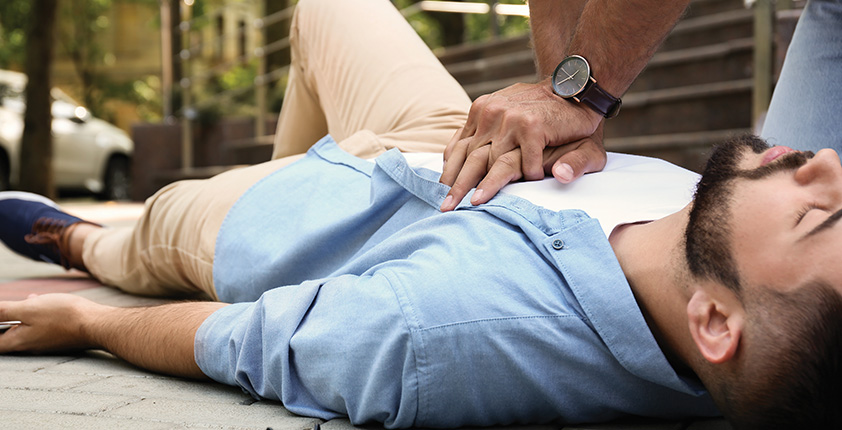Steps to successful CPR
Many of us share an instinct to help in an emergency. But we're not always ready to help.
Often we hesitate because we're unsure of what to do or fear we'll make a situation worse. Unfortunately, hesitating in the event of a sudden cardiac arrest (SCA) can have far reaching consequences.
For each passing minute after collapsing, a victim's survival from SCA decreases by 10%, so it's important to remain calm and act quickly. So important, in fact, that in the U.S., 38 states and the District of Columbia include CPR training in their requirements for students graduating from high school.
Familiarize yourself with these steps so you're empowered to help provide high-quality CPR before emergency services arrive. There are also many community organizations that offer CPR training courses. In an emergency, the following list of important steps can help serve as a reminder of how to respond before EMS arrives.
First, check to see if the victim is breathing. If not, ask someone to call 911 and find an automated external defibrillator (AED).
Next, begin cardiopulmonary resuscitation (CPR):
- Kneel beside the victim and make sure the victim is on their back.
- Place the heel of your hand in the center of the chest. Place your other hand on top and interlace your fingers.
- Position your body so that your shoulders are directly above your hands. Keep your arms straight. Lean forward, being careful not to shift the full weight of your body onto the victim.
- Begin compressions by pressing hard and fast on the victim's chest. Maintain a rate of 100 to 120 compressions per minute, allowing the chest to rise completely between compressions.
- Continue delivering compressions until an AED is available or an ambulance arrives.
If an AED becomes available, ask someone to turn it on and follow the audio/visual prompts. Open or cut the victim's shirt and make sure their bare chest is dry, working quickly to keep interruptions to CPR to under 10 seconds. Apply the AED pads to the victim's chest according to the instructions. Clear the area and ensure that nobody is touching the victim. The AED will analyze the rhythm of the victim's heart and deliver a defibrillating shock if necessary.

Broad deployment of AEDs and increased bystander CPR could prevent as many as 50,000 deaths each year in the U.S. that are caused by SCA.1

Resume CPR after a shock is delivered and continue to follow the AED's guidance. Many AEDs use auditory prompts to talk you through CPR. To ensure victims receive high-quality CPR and the greatest chance at a positive outcome, some AEDs use simple auditory prompts like "Press harder" to guide your depth and rate of compressions.

"Monitoring of CPR quality is arguably one of the most significant advances in resuscitation practice in the past 20 years and one that should be incorporated into every resuscitation and every professional rescuer program."
— AHA CPR Quality Consensus Statement2

When you witness an SCA, remember to remain calm, act quickly, and confidently follow your instinct to help.
Removing barriers to lifesaving help
Another reason we may hesitate in the face of an emergency is fear of liability. To encourage people to step in during an SCA or other emergency, most states and the Federal Government have passed "Good Samaritan" laws. These laws provide basic legal protection for bystanders who help in "good faith" during an emergency. And most states have also enacted AED laws to ensure they are readily available in places such as schools and gyms. Community members should feel comfortable stepping in to help when they witness an SCA or another type of emergency.
You may only have minutes
Just like SCAs, there are many other types of emergencies that can become life-threatening more quickly than emergency services can arrive. Access to Mobilize™; trauma kits and just-in-time instructions means you have support for emergencies of all different types. Knowing how to respond in a stressful situation and having the right tools to do so can help save lives.

1Children's Hospital of Philadelphia website, chop.edu/conditions-diseases/sudden-cardiac-arrest. Accessed 18 Aug 2023.
2Circulation. 2013;128:420.

